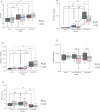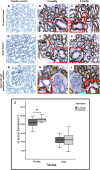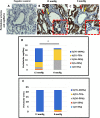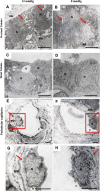Effects of low versus standard pressure pneumoperitoneum on renal syndecan-1 shedding and VEGF receptor-2 expression in living-donor nephrectomy: a randomized controlled study
- PMID: 32019488
- PMCID: PMC7001365
- DOI: 10.1186/s12871-020-0956-7
Effects of low versus standard pressure pneumoperitoneum on renal syndecan-1 shedding and VEGF receptor-2 expression in living-donor nephrectomy: a randomized controlled study
Abstract
Background: Laparoscopic nephrectomy is a preferred technique for living kidney donation. However, positive-pressure pneumoperitoneum may have an unfavorable effect on the remaining kidney and other distant organs due to inflamed vascular endothelium and renal tubular cell injury in response to increased systemic inflammation. Early detection of vascular endothelial and renal tubular response is needed to prevent further kidney injury due to increased intraabdominal pressure induced by pneumoperitoneum. Transperitoneal laparoscopic living donor nephrectomy represented a human model of mild increasing intraabdominal pressure. This study aimed to assess the effect of increased intraabdominal pressure on vascular endothelium and renal tubular cells by comparing the effects of low and standard pressure pneumoperitoneum on vascular endothelial growth factor receptor-2 (VEGFR-2) expression and the shedding of syndecan-1 as the early markers to a systemic inflammation.
Methods: We conducted a prospective randomized study on 44 patients undergoing laparoscopic donor nephrectomy. Subjects were assigned to standard (12 mmHg) or low pressure (8 mmHg) groups. Baseline, intraoperative, and postoperative plasma interleukin-6, syndecan-1, and sVEGFR-2 were quantified by ELISA. Syndecan-1 and VEGFR-2 expression were assessed immunohistochemically in renal cortex tissue. Renal tubule and peritubular capillary ultrastructures were examined using electron microscopy. Perioperative hemodynamic changes, end-tidal CO2, serum creatinine, blood urea nitrogen, and urinary KIM-1 were recorded.
Results: The low pressure group showed lower intra- and postoperative heart rate, intraoperative plasma IL-6, sVEGFR-2 levels and plasma syndecan-1 than standard pressure group. Proximal tubule syndecan-1 expression was higher in the low pressure group. Proximal-distal tubules and peritubular capillary endothelium VEGFR-2 expression were lower in low pressure group. The low pressure group showed renal tubule and peritubular capillary ultrastructure with intact cell membranes, clear cell boundaries, and intact brush borders, while standard pressure group showed swollen nuclei, tenuous cell membrane, distant boundaries, vacuolizations, and detached brush borders.
Conclusion: The low pressure pneumoperitoneum attenuated the inflammatory response and resulted in reduction of syndecan-1 shedding and VEGFR-2 expression as the renal tubular and vascular endothelial proinflammatory markers to injury due to a systemic inflammation in laparoscopic nephrectomy.
Trial registration: ClinicalTrials.gov NCT:03219398, prospectively registered on July 17th, 2017.
Keywords: Interleukin-6; Laparoscopic nephrectomy; Pneumoperitoneum; Renal resistive index; Syndecan-1; sVEGFR-2.
Conflict of interest statement
The authors declare that they have no competing interests.
Figures







Similar articles
-
Effect of Pneumoperitoneum on Renal Resistive Index and Renal Function in Patients Who Have Undergone Laparoscopic Living Donor Nephrectomy: A Pilot Study.Transplant Proc. 2019 Jul-Aug;51(6):1727-1731. doi: 10.1016/j.transproceed.2019.04.045. Epub 2019 Jun 27. Transplant Proc. 2019. PMID: 31255356 Clinical Trial.
-
Comparison of the effectiveness of low pressure pneumoperitoneum with profound muscle relaxation during laparoscopic donor nephrectomy to optimize the quality of recovery during the early post-operative phase: study protocol for a randomized controlled clinical trial.Trials. 2015 Aug 12;16:345. doi: 10.1186/s13063-015-0887-7. Trials. 2015. PMID: 26265279 Free PMC article. Clinical Trial.
-
Deep neuromuscular blockade improves surgical conditions during low-pressure pneumoperitoneum laparoscopic donor nephrectomy.Surg Endosc. 2018 Jan;32(1):245-251. doi: 10.1007/s00464-017-5670-2. Epub 2017 Jun 22. Surg Endosc. 2018. PMID: 28643056 Free PMC article. Clinical Trial.
-
Renal implications of pneumoperitoneum in laparoscopic surgery: mechanisms, risk factors, and preventive strategies.Korean J Anesthesiol. 2024 Dec;77(6):575-586. doi: 10.4097/kja.24011. Epub 2024 Apr 26. Korean J Anesthesiol. 2024. PMID: 38664893 Free PMC article. Review.
-
[Ischemia-reperfusion syndrome and role of preservation graft technique after laparoscopic versus open nephrectomy in a experimental model of living donor kidney transplant].Actas Urol Esp. 2008 Jan;32(1):119-27. doi: 10.1016/s0210-4806(08)73802-6. Actas Urol Esp. 2008. PMID: 18411630 Review. Spanish.
Cited by
-
Low intra-abdominal pressure in laparoscopic surgery: a systematic review and meta-analysis.Int J Surg. 2023 May 1;109(5):1400-1411. doi: 10.1097/JS9.0000000000000289. Int J Surg. 2023. PMID: 37026807 Free PMC article.
-
Effect of low-pressure pneumoperitoneum on pain and inflammation in laparoscopic cholecystectomy: a randomized controlled clinical trial.BMC Res Notes. 2023 Sep 28;16(1):235. doi: 10.1186/s13104-023-06492-y. BMC Res Notes. 2023. PMID: 37770908 Free PMC article. Clinical Trial.
-
Biochemical implications of robotic surgery: a new frontier in the operating room.J Robot Surg. 2024 Feb 24;18(1):91. doi: 10.1007/s11701-024-01861-6. J Robot Surg. 2024. PMID: 38401027 Review.
-
Pediatric Challenges in Robot-Assisted Kidney Transplantation.Front Surg. 2021 Mar 25;8:649418. doi: 10.3389/fsurg.2021.649418. eCollection 2021. Front Surg. 2021. PMID: 33842532 Free PMC article.
-
Effects of pneumoperitoneum on kidney injury biomarkers: A randomized clinical trial.PLoS One. 2021 Feb 19;16(2):e0247088. doi: 10.1371/journal.pone.0247088. eCollection 2021. PLoS One. 2021. PMID: 33606739 Free PMC article. Clinical Trial.
References
-
- Smit M, Hofker HS, Leuvenink HG, Krikke C, Jongman RM, Zijlstra JG, van Meurs M. A human model of intra-abdominal hypertension: even slightly elevated pressure lead to increased acute systemic inflammation and signs of acute kidney injury. Crit Care. 2013;17(2):425. doi: 10.1186/cc12568. - DOI - PMC - PubMed
-
- Kirkpatrick AW, Roberts DJ, De Waele J, Jaeschke R, Malbrain ML, De Keulenaer B, et al. Intra-abdominal hypertension and the abdominal compartment syndrome: updated consensus definitions and clinical practice guidelines from the world Society of the Abdominal Compartment Syndrome. Intensive Care Med. 2013;39(7):1190–1206. doi: 10.1007/s00134-013-2906-z. - DOI - PMC - PubMed
Publication types
MeSH terms
Substances
LinkOut - more resources
Full Text Sources
Medical

